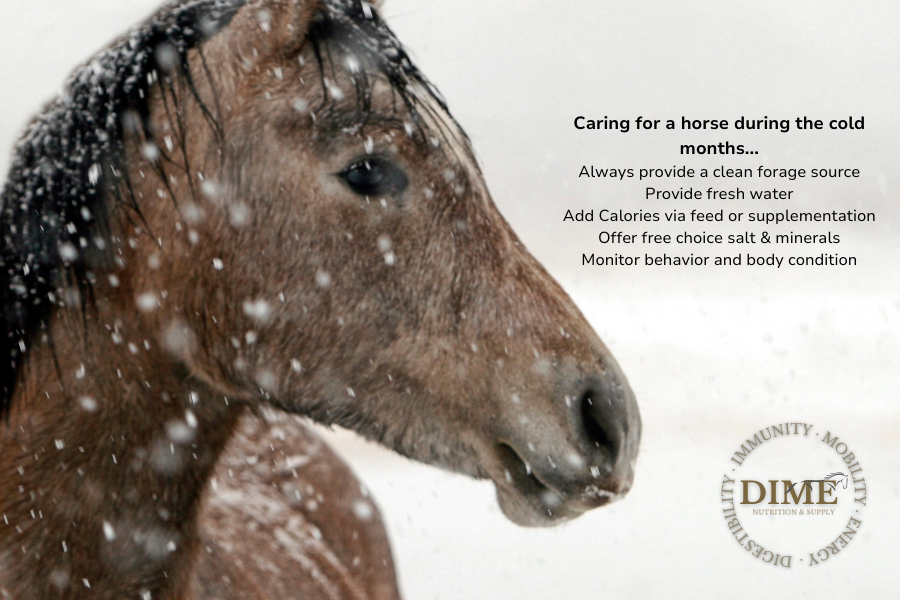
Tips for Optimal Nutrition During the Cold Winter Months
Share
As temperatures drop and winter conditions spread across the landscape, horse owners face the challenge of ensuring their equine companions receive the proper nutrition to stay healthy and comfortable. During these colder months, a horse’s dietary needs change, requiring careful attention to maintain their energy levels, body condition, and overall well-being. In this blog, we will discuss essential feeding strategies to keep your horse thriving through the winter chill.
Let’s not forget that horses are naturally designed to handle cold weather, but they do require adjustments in their diet to meet the increased energy demands associated with lower temperatures. Here are key factors to consider:
Increased Caloric Intake: When temperatures drop, horses expend more energy to maintain their body heat. To counteract this, you may need to increase the caloric content of their diet. The most cost effective way would be to increase their hay intake or add a high caloric supplement to their grain such as cold-milled flax or rice bran.
Quality Forage: Forage should remain the cornerstone of your horse’s diet, even in winter. High-quality hay is crucial, as it provides fiber necessary for digestion and helps maintain warmth. As with any time of year, look for hay that is free of mold and dust!
Supplementing with Grain: If your horse is working hard or has difficulty maintaining weight, consider supplementing their diet with grains or concentrated feeds. We also suggest single-ingredient supplementation like oats, cracked corn, cold milled flax, alfalfa pellets, rice bran and coconut meal.
Water Intake: It’s easy to overlook hydration during winter, but horses still need access to fresh, unfrozen water. Cold temperatures can reduce their thirst, so ensure they have a reliable water source. Heated buckets or troughs can help keep water at a drinkable temperature.
Minerals and Vitamins: Horses may require additional vitamins and minerals during winter, particularly if they’re not receiving as much fresh forage. Consider providing a mineral supplement or a balanced feed that meets their nutritional needs. Free choice salt will help keep horses drinking water and replenishing electrolytes.
Feeding Strategies for Winter
Frequent, Smaller Meals: If possible, feed your horse smaller, more frequent meals throughout the day. This can help maintain energy levels and body temperature, as digestion generates heat.
Monitor Body Condition: Regularly assess your horse’s body condition and adjust their feed accordingly. If they are losing weight, increase their feed gradually. Conversely, if they are becoming overweight, consider reducing their caloric intake.
ALWAYS Avoid Sudden Changes: Horses thrive on routine, so try to maintain a consistent feeding schedule. Avoid sudden changes to their diet, as these can lead to digestive upset.
Provide Shelter: While not directly related to feeding, ensure your horse has access to adequate shelter from wind and extreme cold. A well-ventilated barn or windbreak can help them conserve energy and maintain body heat.
Warm Up Feed: If you feed a wet diet try using warm water! This will help the feed intake of older horses and those with dental issues.
What to Look For...
Be vigilant for signs that your horse may be struggling with the cold. These can include:
- Weight loss or poor body condition
- Decreased appetite
- Behavioral changes, such as increased irritability
- Signs of colic or digestive distress
Feeding horses during the cold winter months requires special attention and care. By understanding their increased nutritional needs, providing high-quality forage, and ensuring access to fresh water, you can help your horse stay healthy and comfortable throughout the season. Regular monitoring and adjustments to their diet will ensure they maintain their energy levels and overall well-being. With the right approach, you and your horse can enjoy the beauty of winter together, thriving in the frosty air!
